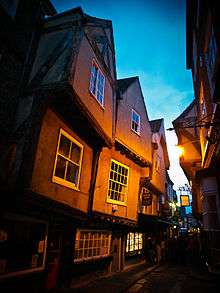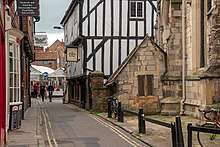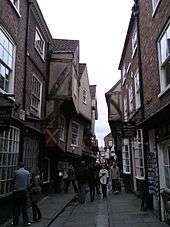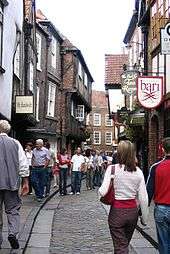The Shambles

The Shambles (officially known as just Shambles[1]) is an old street in York, England, with overhanging timber-framed buildings, some dating back as far as the fourteenth century. It was once known as The Great Flesh Shambles, probably from the Anglo-Saxon Fleshammels (literally 'flesh-shelves'), the word for the shelves that butchers used to display their meat. As recently as 1872 twenty-five butchers' shops were located along the street, but now none remain.

The street was mentioned in the Domesday Book of 1086. Many of the current buildings are from circa 1350-1475.[2] Among the structures of the Shambles is a shrine to Saint Margaret Clitherow, who was married to a butcher who owned and lived in a shop there at No. 10 Shambles. Her home is now a cufflinks shop, Cuffs & Co, and features the priest hole fireplace that ultimately led to her death.[3][4]
Although the butchers have now vanished, a number of the shops on the street still have meat-hooks hanging outside and, below them, shelves on which meat would have been displayed. The shops currently include a mixture of eateries and souvenir sellers, but there is also a bookshop and a bakery. Five snickelways lead off the Shambles. A daily market (Shambles Market) operates in the area.[5]

There are streets named "The Shambles" in other UK towns (e.g., Bradford on Avon, Chesterfield, Guildford in Surrey, Swansea, Chippenham, Manchester, Sevenoaks, Whitby, Worcester, Armagh), and in Ireland (there is a Fishamble Street in Dublin).
Ancient market


"Shambles" is an obsolete term for an open-air slaughterhouse and meat market. Streets of that name were so called from having been the sites on which butchers killed and dressed animals for consumption. (One source suggests that the term derives from "Shammel", an Anglo-Saxon word for shelves that stores used to display their wares while another indicates that by AD 971 "shamble" meant a 'bench for the sale of goods' and by 1305, a 'stall for the sale of meat'. )[2][6]
The Shambles in Stroud still has the hinged wooden boards attached to the shops, and hosts a regular local market.
The Shambles in Shepton Mallet, Somerset is a much shorter replica of the fourteenth century shambles that housed the regular Monday market since 1318. The market however was moved to Friday in 1641 and is still held around the local shambles monument.
During that period there were no sanitary facilities or hygiene laws as exist today, and guts, offal, and blood were thrown into a runnel down the middle of the street or open space where the butchering was carried out.
See also
References
- ↑ Franks, Alan (12 July 2017). "What a Shambles: a walk around York's ancient walls and alleys". The Guardian. Retrieved 7 November 2017.
- 1 2 "The Shambles: History of York". www.historyofyork.org.uk. Retrieved 18 June 2018.
- ↑ "About us". Cuffs & Co. Retrieved 3 October 2018.
- ↑ "The Pearl of York". BBC News. 9 October 2008. Retrieved 3 October 2018.
- ↑ "Anger as York's Shambles Market traders miss out on days work due to closure". York Press. Retrieved 18 June 2018.
- ↑ Martin, Gary. "'A complete shambles' - the meaning and origin of this phrase". Phrasefinder. Retrieved 18 June 2018.
Sources
- Pevsner, Nikolaus; revised by Neave, David (1995) [1972]. The Buildings of England Yorkshire: York and the East Riding (2nd ed.). Harmondsworth: Penguin Books. ISBN 0-14-071061-2.
External links
| Look up shambles in Wiktionary, the free dictionary. |
| Wikimedia Commons has media related to The Shambles, York. |
- The Shambles Official Website
- The Shambles at Yorkshire Guides
- This is York
- York Shambles tour QuickTime virtual reality image of the Shambles
Coordinates: 53°57′33.85″N 1°4′48.40″W / 53.9594028°N 1.0801111°W